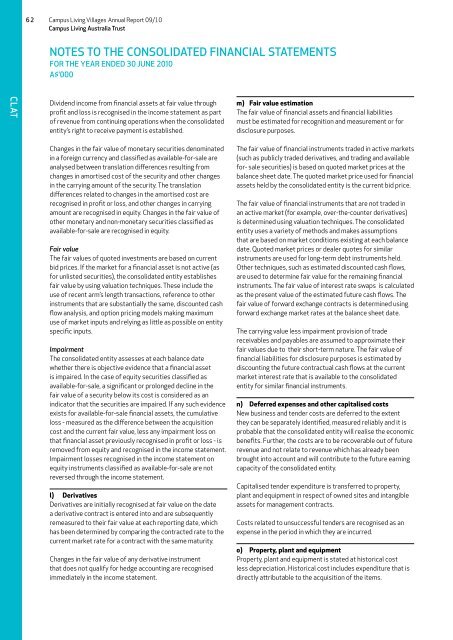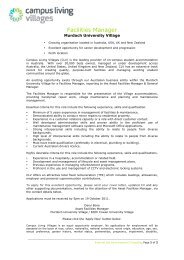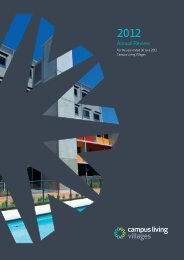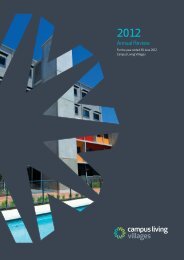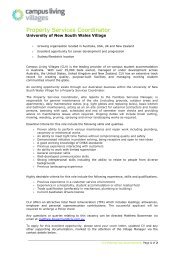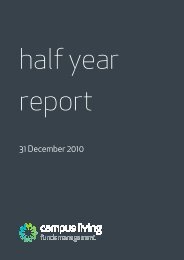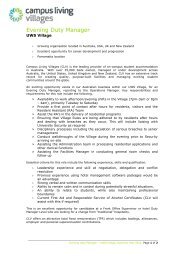Annual Report - Campus Living Villages
Annual Report - Campus Living Villages
Annual Report - Campus Living Villages
Create successful ePaper yourself
Turn your PDF publications into a flip-book with our unique Google optimized e-Paper software.
6 2 <strong>Campus</strong> <strong>Living</strong> <strong>Villages</strong> <strong>Annual</strong> <strong>Report</strong> 09/10<br />
<strong>Campus</strong> <strong>Living</strong> Australia Trust<br />
NOTES TO THE CONSOLIDATED FINANCIAL STATEMENTS<br />
FOR THE YEAR ENDED 30 JUNE 2010<br />
A$’000<br />
CLAT<br />
Dividend income from financial assets at fair value through<br />
profit and loss is recognised in the income statement as part<br />
of revenue from continuing operations when the consolidated<br />
entity’s right to receive payment is established.<br />
m) Fair value estimation<br />
The fair value of financial assets and financial liabilities<br />
must be estimated for recognition and measurement or for<br />
disclosure purposes.<br />
Changes in the fair value of monetary securities denominated<br />
in a foreign currency and classified as available-for-sale are<br />
analysed between translation differences resulting from<br />
changes in amortised cost of the security and other changes<br />
in the carrying amount of the security. The translation<br />
differences related to changes in the amortised cost are<br />
recognised in profit or loss, and other changes in carrying<br />
amount are recognised in equity. Changes in the fair value of<br />
other monetary and non-monetary securities classified as<br />
available-for-sale are recognised in equity.<br />
Fair value<br />
The fair values of quoted investments are based on current<br />
bid prices. If the market for a financial asset is not active (as<br />
for unlisted securities), the consolidated entity establishes<br />
fair value by using valuation techniques. These include the<br />
use of recent arm’s length transactions, reference to other<br />
instruments that are substantially the same, discounted cash<br />
flow analysis, and option pricing models making maximum<br />
use of market inputs and relying as little as possible on entity<br />
specific inputs.<br />
Impairment<br />
The consolidated entity assesses at each balance date<br />
whether there is objective evidence that a financial asset<br />
is impaired. In the case of equity securities classified as<br />
available-for-sale, a significant or prolonged decline in the<br />
fair value of a security below its cost is considered as an<br />
indicator that the securities are impaired. If any such evidence<br />
exists for available-for-sale financial assets, the cumulative<br />
loss - measured as the difference between the acquisition<br />
cost and the current fair value, less any impairment loss on<br />
that financial asset previously recognised in profit or loss - is<br />
removed from equity and recognised in the income statement.<br />
Impairment losses recognised in the income statement on<br />
equity instruments classified as available-for-sale are not<br />
reversed through the income statement.<br />
l) Derivatives<br />
Derivatives are initially recognised at fair value on the date<br />
a derivative contract is entered into and are subsequently<br />
remeasured to their fair value at each reporting date, which<br />
has been determined by comparing the contracted rate to the<br />
current market rate for a contract with the same maturity.<br />
Changes in the fair value of any derivative instrument<br />
that does not qualify for hedge accounting are recognised<br />
immediately in the income statement.<br />
The fair value of financial instruments traded in active markets<br />
(such as publicly traded derivatives, and trading and available<br />
for- sale securities) is based on quoted market prices at the<br />
balance sheet date. The quoted market price used for financial<br />
assets held by the consolidated entity is the current bid price.<br />
The fair value of financial instruments that are not traded in<br />
an active market (for example, over-the-counter derivatives)<br />
is determined using valuation techniques. The consolidated<br />
entity uses a variety of methods and makes assumptions<br />
that are based on market conditions existing at each balance<br />
date. Quoted market prices or dealer quotes for similar<br />
instruments are used for long-term debt instruments held.<br />
Other techniques, such as estimated discounted cash flows,<br />
are used to determine fair value for the remaining financial<br />
instruments. The fair value of interest rate swaps is calculated<br />
as the present value of the estimated future cash flows. The<br />
fair value of forward exchange contracts is determined using<br />
forward exchange market rates at the balance sheet date.<br />
The carrying value less impairment provision of trade<br />
receivables and payables are assumed to approximate their<br />
fair values due to their short-term nature. The fair value of<br />
financial liabilities for disclosure purposes is estimated by<br />
discounting the future contractual cash flows at the current<br />
market interest rate that is available to the consolidated<br />
entity for similar financial instruments.<br />
n) Deferred expenses and other capitalised costs<br />
New business and tender costs are deferred to the extent<br />
they can be separately identified, measured reliably and it is<br />
probable that the consolidated entity will realise the economic<br />
benefits. Further, the costs are to be recoverable out of future<br />
revenue and not relate to revenue which has already been<br />
brought into account and will contribute to the future earning<br />
capacity of the consolidated entity.<br />
Capitalised tender expenditure is transferred to property,<br />
plant and equipment in respect of owned sites and intangible<br />
assets for management contracts.<br />
Costs related to unsuccessful tenders are recognised as an<br />
expense in the period in which they are incurred.<br />
o) Property, plant and equipment<br />
Property, plant and equipment is stated at historical cost<br />
less depreciation. Historical cost includes expenditure that is<br />
directly attributable to the acquisition of the items.


